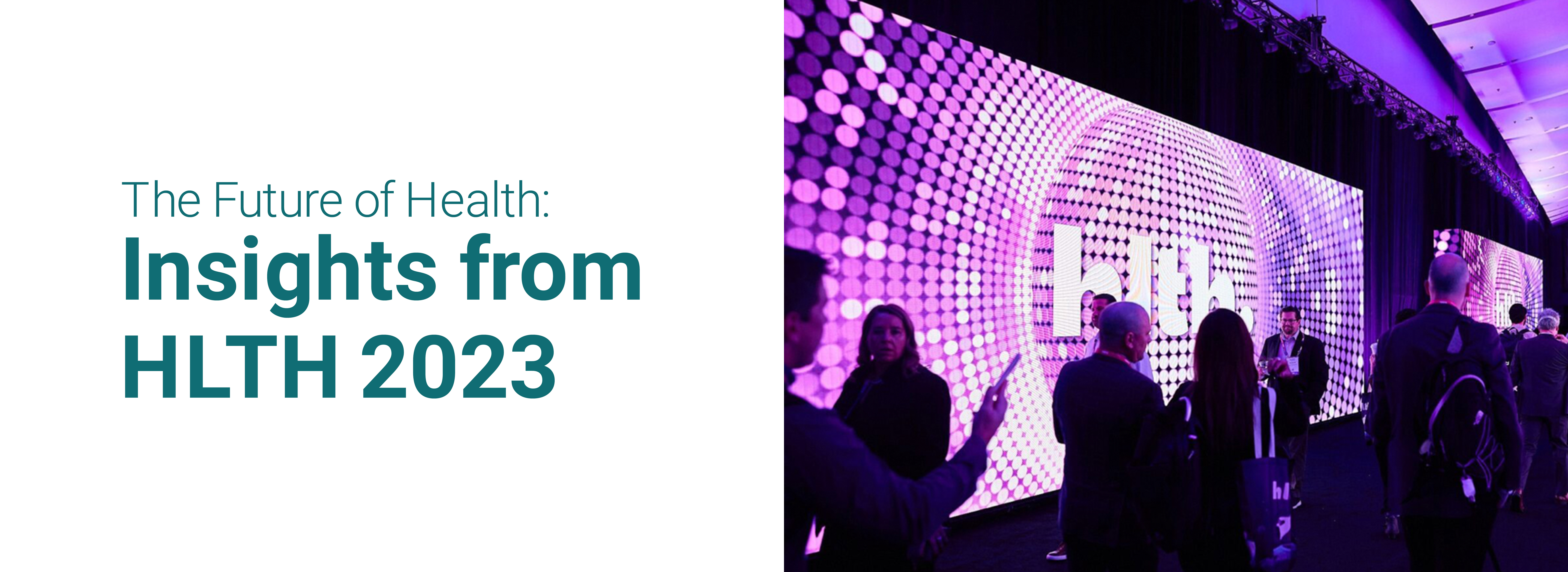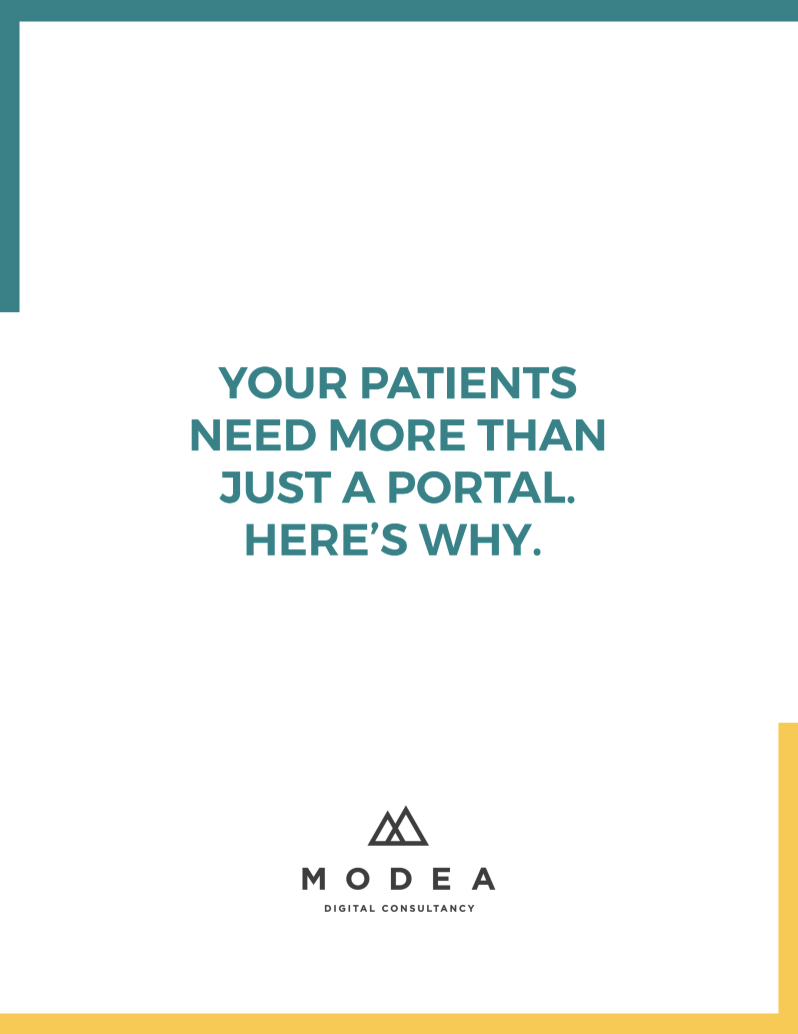
Earlier this month, healthcare professionals from across the globe converged in Las Vegas for the annual HLTH conference. The event highlights the conversations shaping the future of healthcare delivery, technology, and policy. Leaders across the healthcare continuum shared their challenges and insights through panels on virtual care, health equity, data integrity, and interoperability. Additionally, they discussed the patient and caregiver experience, and digital innovation. Modea sent three of our own to learn from the best and brightest minds in the industry.
As healthcare consultants, Modea attended HLTH to explore the digital healthcare landscape among 10,000+ industry peers. There was no shortage of inspiration.
We learned about new technologies that enable better virtual care, opportunities to improve interoperability and, as a result, both the patient and provider experiences, and innovative use cases of generative AI. We’re eager to bring this inspiration forward into our product development work as we partner with our clients to better serve their customers.
In this blog post, we’ll cover our top takeaways from HLTH, and we’ll summarize how you might bring these insights into your consumer-facing product development practices.
Investing in the Entire Caregiving Experience is Crucial
The caregiver experience often remains an afterthought. However, caregivers tend to carry substantial purchasing power in healthcare, and therefore, caregiver satisfaction strongly predicts loyalty. Caregivers, like patients, will switch providers based on a poor or inefficient experience – digital and otherwise.
So how can payers and providers elevate the caregiver experience? Solutions that provide consolidated, thorough family health records, centralized scheduling, care coordination, and resources to ease the complex balancing act of caregiving are table stakes. Measurement is also important. Just as health systems measure patient experience from a clinical standpoint, measuring the wraparound care experience for patients and caregivers will help identify successes and opportunities. For instance, health systems might consider facilitating surveys to better understand the caregiver experience. Monitoring call volume metrics can also be an indicator of caregiver experience; reduced calls can indicate that caregivers are able to accomplish tasks via virtual self-service.
Another consideration here is that women are more likely than men to be their family caregivers (a statistic that was exacerbated by the COVID-19 pandemic). Furthermore, the administrative burden of caregiving falls disproportionately on women of color. As such, reducing the caregiver burden is not only important from a patient/caregiver loyalty perspective, but from an equity perspective, as well. By reducing caregiver burden for women (and women of color), health systems can enable these caregivers to have more time for work, addressing their own healthcare needs, and more.
How to Apply this to Your Product Development Work: Caregiver User Research
From research through design, development, and testing, product development for patient populations often begins with a thorough study of the patient journey. However, there’s room for improvement in understanding not only the patient or patient-family journey (in the case of children’s hospitals) but also the experience of any caregiver involved in that patient’s care, be it a parent, spouse, child, or others. By better assessing the caregiver journey—considering their challenges, desires, and experience—product teams can intentionally create products that enhance not only the patient experience but also drive efficiencies for caregivers. Prioritizing products that improve the caregiver experience contributes to ROI, enabling the provision of more care to more people.
Leveraging Tech to Strengthen Patient-Provider Relationships
Virtual care promises convenience but threatens to jeopardize the human relationships at the heart of healthcare. Still, virtual care is necessary for improving access to care. Successfully scaling virtual medicine requires technology that augments trust and rapport between patients and providers.
We learned about several technologies aiming to strengthen the patient-provider relationship, and in doing so, improve the care experience. Leveraging universal patient identifiers is an effective way for patients and providers to consolidate health records. This consolidation offers providers with a fuller context of a patient’s history, ensuring better-informed care decisions. Consider the alternative experience where a provider lacks knowledge of a patient’s health history, potentially leading to inadequate care. Additionally, AI-powered chatbots and virtual assistants play a crucial role in streamlining routine administrative tasks for care teams. By automating these tasks, these technologies free up valuable provider time, allowing them to focus on more meaningful, human-level interactions with patients.
It’s important to remember, however, that solutions must enhance, not replace, human connection.
How to Apply this to Your Product Development Work: Keep Tracking AI Use Cases
On a recent webinar, we heard the quote, “we’re in the flip phone era of AI.” What does that mean? Consider the significant evolution of cellphones since the introduction of the innovative flip phone in 1996. We’re at the dawn of the AI innovation era, where AI will be pivotal in shaping healthcare—accelerating drug discovery and optimizing hospital operations. To stay ahead, healthcare product teams must monitor AI trends, continuously learn, and integrate AI capabilities into consumer-facing products. The value of agile development is emphasized by AI and digital trends, ensuring iterative product building that evolves with accelerating AI innovation.
Community Health and Prevention
“Health is mostly not about healthcare,” declared Dr. Larry Moss, CEO of Nemours Children’s Health. Put in other terms, health mostly happens outside of the walls of a hospital or clinic. Education, nutrition, housing, and other social determinants drive the lion’s share of health outcomes. (Addressing social determinants of health was a big theme at the ViVE conference earlier this year.)
At HLTH, there was a lot of focus on solutions that address health outside of healthcare. For instance, Instacart Health’s Food as medicine program, which will now provide access to Medicare Advantage members, as well as the broader Well at HLTH exhibit, both underscore the emphasis of nutrition – and equitable access to nutritious foods – on health outcomes.
Digital health companies can support providers in navigating new value-based incentives. This includes offering platforms and tools like patient engagement solutions for prevention and treatment adherence. Additionally, tools that actively involve patients in their care and community-level interventions can contribute to success.
How to Apply this to Your Product Development Work: Personal and Community-Level Journeys
The tools patients use to manage their health will continue evolving, both at the personal and community level. As you shape and assess your organization’s strategies and goals for the consumer digital experience, it’s crucial to grasp the new characteristics and solutions for the patient journey. This understanding will aid in evaluating the potential impact of product development initiatives. For example, consider how patients engage with care not only within the health system and digital platforms but also beyond those boundaries. What are they facing in their community that may impact their health outcomes? Do they have access to healthy food and pharmacies? How might your digital tools help level the playing field for members of your patient population with different personal or community-level experiences?
A Focus on Whole Person Health
Historically, care delivery has zeroed in on isolated conditions and episodes. But momentum is building around “whole person health,” which considers the complete physical, mental, and social needs of patients. Whole person health represents a societal shift as much as a clinical one as patients themselves can drive more of their care and health outcomes.
We heard from innovators changing the face of at-home diagnostics, advancing stress and fitness tracking, and focusing on underlying, root causes of conditions. Importantly, none of these innovations can exist in a vacuum. For “whole person health” solutions to take root, they must integrate with existing care pathways, whether that means connecting to patient health records, appointment scheduling, or treatment plans.
How to Apply this to Your Product Development Work: Rethink the Meaning of Omni-Channel
Whole person health takes omni-channel patient experience one step further. Traditionally at Modea, we’ve emphasized omni-channel care for a seamless transition between digital and analog points in the care journey. To fully encompass whole person health solutions, omni-channel must also consider everything the patient does outside traditional care settings, whether virtual or analog. What is the patient managing in their own time, on their own devices? How will these personalized health solutions integrate with the products you are building for their patients? Product teams that are paying attention to the whole person will be able to better serve the needs of the whole patient.
In Summary
In the case of HLTH, what happened in Las Vegas will not stay in Las Vegas. Rather, it will carry implications for years to come. Along with 10,000+ of our industry peers last week, we learned about the innovations and frictions that will shape the future of healthcare. We hope that the insights and applications we shared through this article will help inspire you to think differently about your product development processes, whether in how you study your users, how you test your products, or how you build products that will adapt and evolve with new technologies.
Here at Modea, as consultants helping our clients shape the digital healthcare experience, we are eager to carry these learnings forward into our work. Get in touch with us if you want to learn more about how we can apply these industry trends to day-to-day product development for your organization.


